Lithuania's housing market mixed
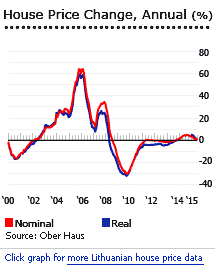 Lithaunia’s housing market shows mixed results, amidst economic slowdown. House prices continue to rise, but only modestly. While property demand remains depressed, residential construction activity has bounced back strongly.
Lithaunia’s housing market shows mixed results, amidst economic slowdown. House prices continue to rise, but only modestly. While property demand remains depressed, residential construction activity has bounced back strongly.
Lithuania’s five major cities’ apartment price index (covering Vilnius, Kaunas, Klaipėda, Šiauliai and Panevėžys) rose by 3.39% (2.35% inflation-adjusted) y-o-y in April 2016, according to Ober Haus Real Estate Advisors.
Apartment prices in the capital, Vilnius, have risen by 17.1% since the post-crisis low of May 2010, a slow and steady rise.
During the year to April 2016:
- In Vilnius average apartment prices rose 4.6%, to €1,352 per square metre (sq. m.).
- In Kaunas, apartment prices rose by 1.8%, to €957 per sq. m.
- In Klaipėda, apartment prices increased 1.7%, to an average of €992 per sq. m
- In Šiauliai, apartment prices increased 2.5%, to an average of €573 per sq. m.
- In Panevėžys, existing flats rose by 1.8%, to an average of €539 per sq. m.
Demand remains very weak. Transactions for apartments dropped 9.8% in 2015 from a year earlier while land purchase transactions fell by 1.8%.
On the other hand, the number of dwellings for which building permits were granted rose by 18.6% y-o-y in 2015 while dwellings completions surged by 33.5%, based on figures from Statistics Lithuania.
Private ownership accounted for around 98% of the total area of dwelling stock in 2015.
Except for agricultural lands, there are virtually no restrictions in foreign ownership of land in Lithuania.
Lithuania’s economic growth slowed to 1.6% in 2015, after expanding by 3% in 2014, 3.3% in 2013, 3.8% in 2012, 6.1% in 2011, and 1.6% in 2010. In the first quarter of 2016, Lithuania’s economy grew by 2.4% compared to the same period last year, thanks to strong domestic consumption, according to Statistics Lithuania. The economy is expected to expand by a modest 2.7% this year and by another 3.1% in 2017, according the International Monetary Fund (IMF). Lithuania finally joined the eurozone in January 1, 2015.
That crazy housing boom and bust
Before the global crisis, Lithuania saw enormous house price increases. The average price of old apartments in Central Vilnius rose 275% between 2002 and 2006:
- In 2003, house prices increased 28%
- In 2004, house prices increased 29%
- In 2005, house prices increased 45%
- In 2006, house prices increased 56%
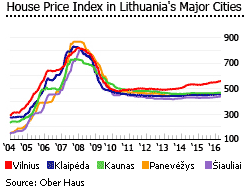
The average price of newly constructed one-bedroom apartments in central Vilnius rose 162% from 2002 to 2006.
Residential property prices in the capital started to decline in 2008, after the global credit crunch. The housing market has not yet fully recovered since then.
- In 2008, house prices fell by 15.23% (-21.85% inflation-adjusted)
- In 2009, house prices fell by 26.84% (-27.77% inflation-adjusted)
- In 2010, house prices fell by 2.98% (-6.55% inflation-adjusted)
- In 2011, house prices dropped by 0.64% (-3.91% inflation-adjusted)
- In 2012, house prices dropped by 1.65% (-4.36% inflation-adjusted)
In 2013, the property market finally recovered with house prices rising by 1.12 (0.76% inflation-adjusted) from a year earlier. In 2014, house prices rose by 3.34% (3.61% inflation-adjusted). Last year, house prices rose modestly by 2.29% (2.38% inflation-adjusted).
Property demand declining
Property demand remains depressed in Lithuania, amidst economic slowdown.
In Lithuania:
- Apartments purchase-sale transactions dropped 9.8% y-o-y to 27,652 units in 2015, based on figures from SE Centre of Registers.
- For private homes, purchase-sale transactions dropped 7% y-o-y to 11,908 units in 2015.
- Land transactions fell by 1.8% y-o-y to 28,464 units in 2015.
In Vilnius:
- Apartment purchase-sale transactions dropped 3.3% y-o-y to 9,108 units in 2015
- Private house purchase-sale transactions in Vilnius city increased 1.8% y-o-y to 1,521 units in 2015 but dropped 0.8% to 632 units in Vilnius region.
- Land transactions in Vilnius city rose by 9.7% y-o-y to 1,441 units in 2015. Over the same period, land transactions fell by 3.1% to 1,883 units.
Construction activity regaining momentum
During the 1980s, when the country was still socialist, more than 20,000 dwelling units were built annually.
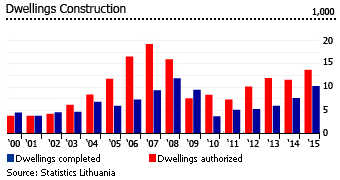
Completions dropped to less than 5,000 annually between 1998 and 2003, leaving a huge, pent-up demand.
As the economy gathered steam, housing construction accelerated:
- In 2004-2006 dwellings completions rose to an average of 6,700 yearly
- In 2007, there were 9,286 completed dwellings
- In 2008 dwelling completions rose to 11,286, the highest since 1992
From 2005 to 2008, almost 16,000 dwellings were authorized annually - around three times the number of completions.
Then suddenly things stalled. In 2009, dwelling completions dropped to 9,400 units. Dwellings authorized fell from 19,229 units in 2007, to 7,553 in 2009. Completions averaged just 5,500 units annually from 2010 to 2014, and dwellings authorized also dropped to an annual average of just 9,800 units in 2010-14.
Recently, construction activity has picked up:
- The number of dwellings for which building permits were granted surged 18.6% y-o-y to 13,706 units in 2015, based on figures from Statistics Lithuania.
- Dwelling completions soared 33.5% y-o-y to 10,177 units in 2015. Likewise, the number of new residential buildings completed rose by 28.1% to 5,707 over the same period.
The total area of dwelling stock increased by 1.2% to 87.9 million sq. m. in 2014, according to Statistics Lithuania.
Mortgage market improving
Mortgage debt rose from a mere 0.4% of GDP in 2000, to 22.4% of GDP in 2009, with about 80% of all purchases made with the aid of mortgages, and typically 95% of property value granted in loans.
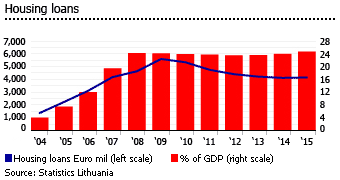
However, the mortgage market started to decline in 2010 and its size fell to 16.45% of GDP in 2014. The market started to improve in 2015, with the total outstanding housing loans in Lithuania increasing by 2.85% y-o-y and the size of the mortgage market expanding slightly to 16.6% of GDP, according to the Bank of Lithuania.
In April 2016, the total housing loans outstanding increased 5.8% to €6.27 billion from the same period last year. About 98% of the total loans have initial rate fixation of over 5 years. The amount of housing loan transactions in April 2016 amounted to €44 million, up from €28.9 million in the previous year.
Interest rates remain low
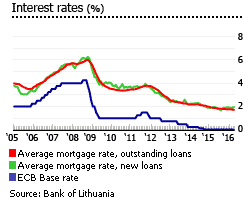
Before the adoption of the euro as Lithuania’s official currency, the litas was pegged to the U.S. dollar at US$ 1 = LTL4 from 1994 to January 2002. From 1999 to 2001, average housing loan rates fluctuated from 8% to 14%.
In February 2002 the litas was re-pegged to the euro at €1 = LTL3.4528. Housing loan interest rates declined to less than 6% in 2002, and to less than 4% between July 2005 and May 2006. From 2005 to mid-2007, there was not much difference between interest rates on new housing loans whether denominated in litas or in euro.
The divergence widened in January 2009, and from mid-2009 interest rates on the two currencies seemed to follow different paths.
Interest rates on litas-denominated new housing loans surged to around 10% from April to October 2009, before falling to 6.2% in March 2010, while interest rates on euro-denominated housing loans simply followed the key ECB rate downward. The interest rate hikes of 2006-2009 had disastrous effects, as almost all new loans approved between 2004 and Q3 2006 had an initial rate fixation (IRF) of less than one year.
As well as causing distress to borrowers, the litas rate hikes caused the market to shift to euro. In 2006 only 44% of new loans were denominated in euro, but from 2009 to Q1 2010, the ratio of euro-denominated loans rose to around 80% to 90% of new loans.
Interest rates on housing loans remain low with the adoption of the euro in January 2015. In April 2016, the average interest rate for new housing loans rose was 1.99%, slightly up from 1.93% a year earlier, according to the Bank of Lithuania.
In April 2016:
- The average interest rate for new housing loans with initial rate fixation (IRF) of up to 1 year stood at 1.80%, slightly down from 1.82% a year earlier.
- The average rate for new housing loans with IRF of more than 1 year was 3.07%, up from 2.71% a year ago.
On the other hand, average interest rates for outstanding housing loans fell to 1.71% in April 2016, from 1.87% a year ago. Over the same period:
- The average rate for outstanding loans with IRF of up to 1 year stood at 0.57% in April 2016, down from 0.63% a year earlier.
- The average rate for outstanding loans with IRF of 1-5 years was 2.48%, up from 2.25% a year ago.
- The average rate for outstanding loans with IRF of over 5 years was 1.71%, down from 1.87% a year earlier.
Rental yields in Vilnius moderate to good, and climbing
Rental yields continue to climb in Lithuania. In the first quarter of 2016:
- In Vilnius, the average gross rental yield rose to 5.6% in Q1 2016, from 4.6% in 2010, according to Ober Haus.
- In Kaunas, the gross rental yield stood at 6% in Q1 2016, up from 4.2% in 2010.
- In Klaipeda, the gross rental yield stood at 5.9% in Q1 2016, up from 4.2% in 2010.
While prices tripled in Vilnius from 2002 to 2006, rents stayed mostly flat. From 2002 to 2007, the average rent for a one-bedroom apartment rose by a mere 18% while the average apartment sale price soared by 197% (from € 1,217 per sq. m. to €3,623). However, house prices started to plunge in 2009 due to the global crisis and reached their lowest levels in 2013. During the said period, apartment rents continued to rise, which resulting to increases in gross rental yields in major cities, particularly in Kaunas and Klaipėda.
Modest economic growth, declining unemployment

After average growth of 8.2% from 2001 to 2007 the economy began to slow in 2008, due to contagion from the global financial meltdown. In 2009, economy shrank by almost 15%, the worst recession in the EU, largely due to the bursting of the property bubble, higher tax rates, the end of cheap money and a huge contraction in exports.
In 2010 the economy finally emerged from recession, with GDP growth of 1.6%.
Then in 2011 the Lithuanian economy began to expand strongly, with real GDP growth of 6.1%, the second fastest pace in the EU. In 2013, Lithuania’s economy grew by a healthy 3.3%, after expanding by 3.8% in 2012, according to Statistics Lithuania. In 2014, the economy grew modestly by 2.9%, fuelled by strong domestic demand and a recovery in the real estate and construction sectors.
Lithuania’s growth over the past five years has been impressive. However in 2015, economic growth slowed to 1.6%, the slowest growth since 2009, due to sluggish investment and decline in exports to Russia, the country´s largest single trading partner.
In the first quarter of 2016, Lithuania’s economy grew by 2.4% compared to the same period last year, thanks to strong domestic consumption, according to Statistics Lithuania.
"In the first quarter of 2016, the positive change in GDP was mainly conditioned by whole trade and retail trade, repair of motor vehicles and motorcycles, transportation and storage, and manufacturing activities," said Statistics Lithuania.
The economy is expected to expand by a modest 2.7% this year and by another 3.1% in 2017, according to the IMF.
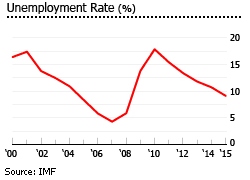
Unemployment continues to fall. In March 2016, the jobless rate stood at 8.5%, down from 8.8% in the previous month and 9% in the same period last year - and down from 17.8% in 2010, according to Statistics Lithuania.
From 2009 to 2014, the country’s unemployment rate averaged 13.8%, sharply up from an average of 6% in 2004-08, according to the IMF.
The country recorded a deflation rate of 0.7% in 2015, the first year of declining consumer prices since 2003, according to Statistics Lithuania. From 2009 to 2014, nationwide inflation rate averaged 2.3%, according to the IMF.
Inflation is expected at 0.5% this year, before accelerating to 1.8% next year, due to falling energy prices, according to Bank of Lithuania.
Lithuania’s budget deficit was just 0.2% of GDP in 2015, down from 0.7% in 2014 and 2.6% in 2013 and far below the 3% limit under the EU’s stability and growth pact. During the global crisis, the deficit had ballooned to 9.4% of GDP in 2009, and remained high in 2010 at 7.2% of GDP, and 8.9% in 2011. Then in 2012, Lithuania adopted a budget that would narrow the public sector deficit to 3.1% of GDP, in a bid to join the eurozone.
Government debt increased to 42.7% of GDP in 2015 from 40.7% of GDP in 2014, but still well below the 60% threshold.
Lithuania joined the Euro on January 1, 2015, the bloc’s 19th member. Lithuania was refused euro entry once before, in 2006, after it failed to meet the inflation criteria. The Litas, which had been pegged to the Euro for a decade, went out of circulation.
After one year of using the Euro, economists assess that it is helping the country weather external shocks. “The euro helped build business confidence and consumer confidence,” said Zygimantas Mauricas of Nordea Bank.
“People thought that the euro would make things more expensive, instead, people ended up making more money. Now you have stability and the common currency just makes it easier to do business and to invest,” added Mauricas.